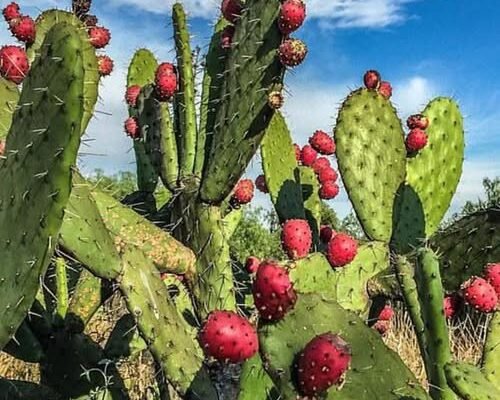Nopal, also known as prickly pear cactus, is a plant native to Mexico and widely used in cooking, traditional medicine, and wellness routines. Both the pads (nopales) and fruit (tunas) are loaded with nutrients and offer a wide range of health benefits.
Let’s explore why this cactus has earned its superfood status — and how you can incorporate it into your daily life.
BENEFITS OF NOPAL

1. Supports Blood Sugar Control
Nopal is high in fiber and antioxidants, which help regulate blood sugar levels.
It may reduce spikes in blood glucose, particularly after meals — making it beneficial for people with type 2 diabetes or insulin resistance.
2. Aids in Weight Management
The rich fiber and water content make you feel full longer, reducing appetite.
Low in calories but high in nutrients — perfect for those looking to manage their weight naturally.
3. Improves Digestion
The dietary fiber in nopal promotes healthy digestion and helps prevent constipation.
Also, it supports gut health by feeding good bacteria.
4. Anti-Inflammatory & Antioxidant Properties
Contains powerful antioxidants like vitamin C, betalains, and polyphenols, which combat inflammation and oxidative stress.
May help reduce symptoms of conditions like gastritis or arthritis.
5. Cholesterol & Heart Health
Some studies suggest nopal can help lower bad (LDL) cholesterol while maintaining or increasing good (HDL) cholesterol.
Its potassium content also supports healthy blood pressure.
6. Boosts Immune System
Nopal is a source of vitamin C, which helps strengthen the immune system and fight off infections.
7. Supports Liver Health
Traditionally used to help detoxify and support liver function.
May reduce liver inflammation and improve metabolic processes.
PROPERTIES OF NOPAL
– High in Fiber: Great for digestion and blood sugar control
– Rich in Antioxidants: Fights free radicals and inflammation
– Low in Calories: Ideal for weight loss diets
– Hydrating: High water content; supports hydration
– Vitamins & Minerals; Includes vitamin C, magnesium, calcium
USES OF NOPAL
– Culinary Uses
– Fresh Pads (Nopales): Commonly cooked or grilled in salads, tacos, eggs, soups, or stews.
– Juice/Smoothies: Blended with fruits or green vegetables.
– Tuna (Prickly Pear Fruit): Eaten raw, juiced, or used in jams and desserts.
Traditional & Medicinal Uses
Used in herbal remedies for treating ulcers, wounds, and inflammation.
As a natural remedy to lower blood sugar and cholesterol.
HOW TO TAKE NOPAL

– Fresh
Wash, de-spine, and slice the pads.
Cook by boiling, grilling, or sautéing.
Ideal for meals or side dishes.
– Juice or Smoothie
Combine raw nopal (peeled and cleaned) with pineapple, orange, cucumber, or celery.
Best taken in the morning on an empty stomach.
– Powder or Capsules
Available as a supplement for convenience.
Follow dosage instructions on the label or consult a healthcare provider.
– Dried or Canned
Found in health food stores or Latin markets.
Make sure it has no added sugar or sodium if used for health reasons.
⚠️ Precautions
May cause mild bloating or diarrhea in some people when consumed in large amounts.
If you are on blood sugar-lowering medications, talk to your doctor first — nopal may amplify their effect.



